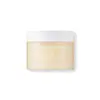What's inside
What's inside
 Key Ingredients
Key Ingredients

 Benefits
Benefits

 Concerns
Concerns

 Ingredients Side-by-side
Ingredients Side-by-side

Water
Skin ConditioningButylene Glycol
HumectantLactococcus Ferment Lysate
Skin ConditioningPolysorbate 20
EmulsifyingMethyl Gluceth-20
HumectantLactic Acid
BufferingPhenoxyethanol
PreservativeBetaine
HumectantPropylene Glycol
HumectantDisodium EDTA
Benzoic Acid
MaskingSodium Hydroxide
BufferingParfum
MaskingDehydroacetic Acid
PreservativeTromethamine
BufferingEthylhexylglycerin
Skin ConditioningPapain
Skin ConditioningSaponins
CleansingSodium Benzoate
MaskingSodium Chloride
MaskingGlycerin
HumectantBehenyl Alcohol
EmollientButyrospermum Parkii Butter
Skin ConditioningHydrogenated Castor Oil
EmollientStearyl Alcohol
EmollientPoria Cocos Extract
Skin ConditioningProtease
ExfoliatingSaponaria Officinalis Leaf/Root Extract
Skin ConditioningSubtilisin
Skin ConditioningTocopheryl Acetate
AntioxidantWater, Butylene Glycol, Lactococcus Ferment Lysate, Polysorbate 20, Methyl Gluceth-20, Lactic Acid, Phenoxyethanol, Betaine, Propylene Glycol, Disodium EDTA, Benzoic Acid, Sodium Hydroxide, Parfum, Dehydroacetic Acid, Tromethamine, Ethylhexylglycerin, Papain, Saponins, Sodium Benzoate, Sodium Chloride, Glycerin, Behenyl Alcohol, Butyrospermum Parkii Butter, Hydrogenated Castor Oil, Stearyl Alcohol, Poria Cocos Extract, Protease, Saponaria Officinalis Leaf/Root Extract, Subtilisin, Tocopheryl Acetate
Water
Skin ConditioningMethylpropanediol
SolventDipropylene Glycol
HumectantGlycerin
HumectantNiacinamide
SmoothingOlea Europaea Fruit Oil
MaskingHydroxyacetophenone
AntioxidantCaprylyl Glycol
EmollientC12-14 Alketh-12
EmulsifyingPolyglyceryl-3 Methylglucose Distearate
EmulsifyingCeramide AP
Skin Conditioning1,2-Hexanediol
Skin ConditioningCarbomer
Emulsion StabilisingBetaine
HumectantArginine
MaskingSodium Citrate
BufferingGlyceryl Stearate Se
EmulsifyingEthylhexylglycerin
Skin ConditioningMethyl Glucose Sesquistearate
EmollientAdenosine
Skin ConditioningCitric Acid
BufferingXanthan Gum
EmulsifyingOryza Sativa Bran Extract
Skin ConditioningOryza Sativa Extract
AbsorbentDipotassium Glycyrrhizate
HumectantDisodium EDTA
Water, Methylpropanediol, Dipropylene Glycol, Glycerin, Niacinamide, Olea Europaea Fruit Oil, Hydroxyacetophenone, Caprylyl Glycol, C12-14 Alketh-12, Polyglyceryl-3 Methylglucose Distearate, Ceramide AP, 1,2-Hexanediol, Carbomer, Betaine, Arginine, Sodium Citrate, Glyceryl Stearate Se, Ethylhexylglycerin, Methyl Glucose Sesquistearate, Adenosine, Citric Acid, Xanthan Gum, Oryza Sativa Bran Extract, Oryza Sativa Extract, Dipotassium Glycyrrhizate, Disodium EDTA
 Reviews
Reviews

Ingredients Explained
These ingredients are found in both products.
Ingredients higher up in an ingredient list are typically present in a larger amount.
Betaine is a common humectant (a substance that promotes retention of moisture). It's known to be gentle on the skin and can help balance hydration.
This ingredient is best for improving hydration and soothing irritated skin. Studies also show it helps even out skin tone.
Fun fact: Betaine is naturally created in the skin and body. The kind found within cosmetic products can be either plant-derived or synthetic.
Another name for betaine is trimethylglycine.
Learn more about BetaineDisodium EDTA plays a role in making products more stable by aiding other preservatives.
It is a chelating agent, meaning it neutralizes metal ions that may be found in a product.
Disodium EDTA is a salt of edetic acid and is found to be safe in cosmetic ingredients.
Learn more about Disodium EDTAEthylhexylglycerin (we can't pronounce this either) is commonly used as a preservative and skin softener. It is derived from glyceryl.
You might see Ethylhexylglycerin often paired with other preservatives such as phenoxyethanol. Ethylhexylglycerin has been found to increase the effectiveness of these other preservatives.
Glycerin is already naturally found in your skin. It helps moisturize and protect your skin.
A study from 2016 found glycerin to be more effective as a humectant than AHAs and hyaluronic acid.
As a humectant, it helps the skin stay hydrated by pulling moisture to your skin. The low molecular weight of glycerin allows it to pull moisture into the deeper layers of your skin.
Hydrated skin improves your skin barrier; Your skin barrier helps protect against irritants and bacteria.
Glycerin has also been found to have antimicrobial and antiviral properties. Due to these properties, glycerin is often used in wound and burn treatments.
In cosmetics, glycerin is usually derived from plants such as soybean or palm. However, it can also be sourced from animals, such as tallow or animal fat.
This ingredient is organic, colorless, odorless, and non-toxic.
Glycerin is the name for this ingredient in American English. British English uses Glycerol/Glycerine.
Learn more about GlycerinWater. It's the most common cosmetic ingredient of all. You'll usually see it at the top of ingredient lists, meaning that it makes up the largest part of the product.
So why is it so popular? Water most often acts as a solvent - this means that it helps dissolve other ingredients into the formulation.
You'll also recognize water as that liquid we all need to stay alive. If you see this, drink a glass of water. Stay hydrated!
Learn more about Water